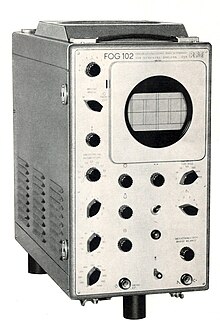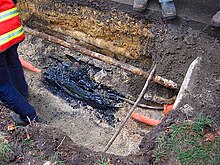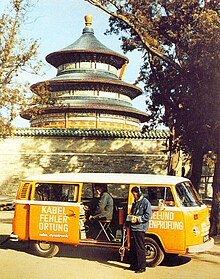Cable fault localisation
The cable fault location is the localization of point defects such as insulation failure in underground cables and is an application of the electrical measurement . Among other things, mobile surge voltage generators are used for this purpose.
History of cable fault location in the GDR
Cable fault location began in Dresden in the post-war period, when the radio manufacturer Radio Mende was expropriated in 1948 and converted into a Soviet-German stock corporation with the new name Funkwerk Dresden . Since a few specialists were available in the field of impulse technology , it was decided to focus on cable measurement technology and implement ideas for a fault location device. In 1952, the FOG 101 was the first fault location device for overhead lines . Most of the devices produced at that time were delivered to the USSR as reparations .
Because of some restructuring within the GDR, the Funkwerk Dresden was initially merged with other Dresden companies in 1969 to form VEB RFT Messelektronik "Otto Schön", until it was incorporated into the Robotron Kombinat in 1979. After the dissolution of the VEB Robotron Kombinat in 1990 and the opening of the markets associated with the reunification of Germany, Messelektronik Dresden had to be made competitive.
Cable fault
Cable faults are damage to cables that cause resistance in the cable and, if continued for a long time , can lead to a voltage breakdown. There are different types of cable faults that must first be classified for cable fault location. The insulation of the cable plays a major role here. While paper pulp cables are particularly susceptible to chemical and thermal effects from the outside, the polyethylene insulation of PE and XLPE cables in the area of high-voltage cables is attacked by the high voltage of the conductor, which leads to partial breakdowns and "eats" cracks in the insulation.
Screen failure
A contact between the conductor and the shield creates a resistance that can vary in size.
Ladder failure
The contact between several conductors creates a resistance that can vary.
Sheath fault
Sheath faults are damage to the cable sheath that allows the surrounding area to come into contact with the cable shield.
Humidity error
Water penetrates the cable jacket and comes into contact with the conductors. Changes in impedance at the fault location make the measurement more difficult. The resistance is mostly in the low-ohm range.
Test wires / signal wires are used, especially for telecommunication cables with plastic-insulated wires, which promptly report the penetration of moisture into the cable. Since in telecommunication cables with plastic-insulated cores the moisture penetrating into the cable core does not initially result in any disadvantageous transmission properties if the core insulation is intact, the moisture that enters remains unnoticed. Two specially designed wires can be used as reporting or test wires, in which z. B. the entire surface of the insulation of these wires is provided with holes, so that penetrated water reaches the conductor and can thus be displayed as quickly as possible.
Interruption
Combination of series and parallel resistances, usually in the form of a break. The voltage is interrupted, i.e. H. .
Cable testing
In order to localize a cable fault, the cable must first be checked for faults. Therefore, cable fault location usually precedes a cable test. During the cable test, flashovers are generated at the weak points in the cable, which can then be localized.
Localization of cable faults
The measures necessary to determine the location of the fault can be broken down into individual steps.
Defect classification
Insulation and resistance measurements provide information about the characteristics of the fault. An insulation test measures the insulation resistance between the conductor and the shield; the resistance measurement over time allows the absorption properties of the insulation material to be derived.
Pre-location
The fault distance is determined in the fault pre-location. There are two predominant methods of doing this.
Impulse reflection method
A pulse induced at the beginning of the cable hits the cable fault with the known speed v and is reflected from there towards the beginning of the cable. The elapsed time divided by two and multiplied by the propagation velocity v gives the expected distance to the source of the error. See also: time domain reflectometry .
Transient procedure
With the transient method, a breakdown is triggered in the event of a cable fault. This causes a low-resistance short circuit for a few milliseconds. This creates two traveling waves propagating in opposite directions in the cable. These are reflected at the cable ends so that they move towards each other again in the direction of the cable fault. This can not be passed due to the arc created by the short circuit ; it is reflected again as with the reflector pulse method, which means that the polarity is reversed due to the burning short circuit. There are various ways of extracting and evaluating these transients.
Route and pinpointing
The location of the faulty cable is determined by means of the route location, and the position of the cable fault is explicitly determined during pinpointing.
Cable selection
During the cable readout, the faulty among the faultless cables is recorded at the location that has already been determined.
Error conversion
After the cable fault has been identified and localized, it is possible to burn it in with the help of burning devices, i.e. H. convert a high resistance to a low resistance fault.
Cable test vehicle
The conventional aid in cable fault testing and location is the cable test van. Cable measurement systems are installed in it so that you can get to the location of the fault as quickly as possible, prepared for any cable fault.





